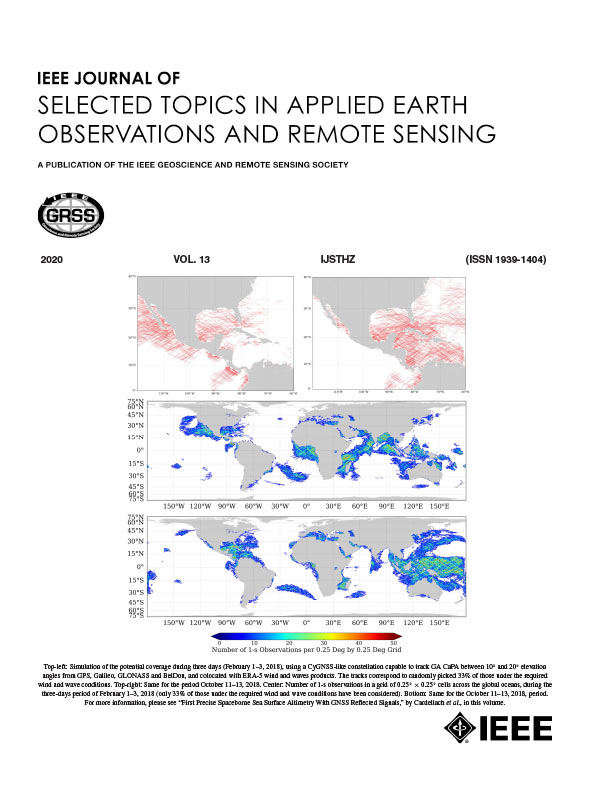1/f-Noise Estimation From Microwave Imager Data With Periodic Gaps
IF 4.7
2区 地球科学
Q1 ENGINEERING, ELECTRICAL & ELECTRONIC
IEEE Journal of Selected Topics in Applied Earth Observations and Remote Sensing
Pub Date : 2024-09-06
DOI:10.1109/JSTARS.2024.3456034
引用次数: 0
Abstract
We describe a method to estimate coefficients从具有周期性间隙的微波成像仪数据中进行 1/f 噪声估计
我们描述了一种估算功率谱密度系数 ${{\bm{h}}}_{\bm{n}}$ 的方法,其形式为 ${\bm\Sigma}}{{{\bm{h}}}_{{\bm{n}}}/{{{\bm{f}}}^{\bm{n}}}$ (${\bm{f}}/{{\bm{n}}};{\bm{}}text{is}$频率和整数${\bm{n}} \geq0$)。该技术用于从发射前地面测试期间收集到的具有不同周期间隙的时间序列数据中持续估算气象系统后续微波成像仪(MWI)信道中存在的1/{bm{f}}$噪声量。该方法假定 MWI 中存在的 1/{\bm{f}}$ 噪声的功率谱可以表示为一个二阶{/{bm{f}}$噪声的功率谱可以表示为二阶频率多项式模型,其形式为${\bm{Sigma}}{{{bm{h}}}_{{\bm{n}}}/{{\bm{f}}}^{\bm{n}}}}{\bm{m{}}$,并试图通过使用具有周期性间隙的时间序列数据的功率谱求解${{\bm{h}}}_{\bm{n}}}$系数来检索真实频谱。的功率谱来求解 ${{bm}{h}}_{bm{n}}$ 系数。该方法还假定数据间隙的周期性和持续时间是已知的,并且对于给定的时间序列是一致的。新技术的理论基础是通过模拟推导和测试得出的,然后将新程序应用于实际测试数据,以估计频率多项式的系数。作为对 1/{{bm{f}}$ 噪声的定量估计,1 Hz 的辐射计增益波动(${\bm{\Delta}}{\bm{G}}/\{bm{G}}$)由增益波动功率谱的频率多项式求解。我们比较了两组地面测试数据的 1 Hz $( {{\bm{\Delta}}{\bm{G}}/{\bm{G}} )$ 值,这两组数据针对的是相同的 MWI 信道,但占空比分别为大(92%)和小(4.89%)。从这两个不同数据集中提取的 1 Hz $( {{\bm{\Delta}}{\bm{G}}/{\bm{G}} )$ 值的相似性增强了对该方法的信心。得出的噪声功率谱可用于模拟 MWIs 辐射亮度温度图像,并预测飞行数据中由于 1/{bm{f}}$ 噪声含量而产生的不需要的条纹程度。该方法可用于求解任何噪声过程功率谱的多项式系数,只要事先知道多项式的形式,就可以将其建模为频率多项式。
本文章由计算机程序翻译,如有差异,请以英文原文为准。
求助全文
约1分钟内获得全文
求助全文
来源期刊
CiteScore
9.30
自引率
10.90%
发文量
563
审稿时长
4.7 months
期刊介绍:
The IEEE Journal of Selected Topics in Applied Earth Observations and Remote Sensing addresses the growing field of applications in Earth observations and remote sensing, and also provides a venue for the rapidly expanding special issues that are being sponsored by the IEEE Geosciences and Remote Sensing Society. The journal draws upon the experience of the highly successful “IEEE Transactions on Geoscience and Remote Sensing” and provide a complementary medium for the wide range of topics in applied earth observations. The ‘Applications’ areas encompasses the societal benefit areas of the Global Earth Observations Systems of Systems (GEOSS) program. Through deliberations over two years, ministers from 50 countries agreed to identify nine areas where Earth observation could positively impact the quality of life and health of their respective countries. Some of these are areas not traditionally addressed in the IEEE context. These include biodiversity, health and climate. Yet it is the skill sets of IEEE members, in areas such as observations, communications, computers, signal processing, standards and ocean engineering, that form the technical underpinnings of GEOSS. Thus, the Journal attracts a broad range of interests that serves both present members in new ways and expands the IEEE visibility into new areas.

 求助内容:
求助内容: 应助结果提醒方式:
应助结果提醒方式:


